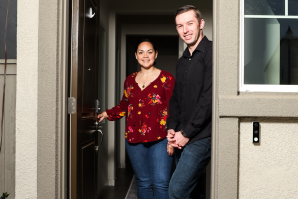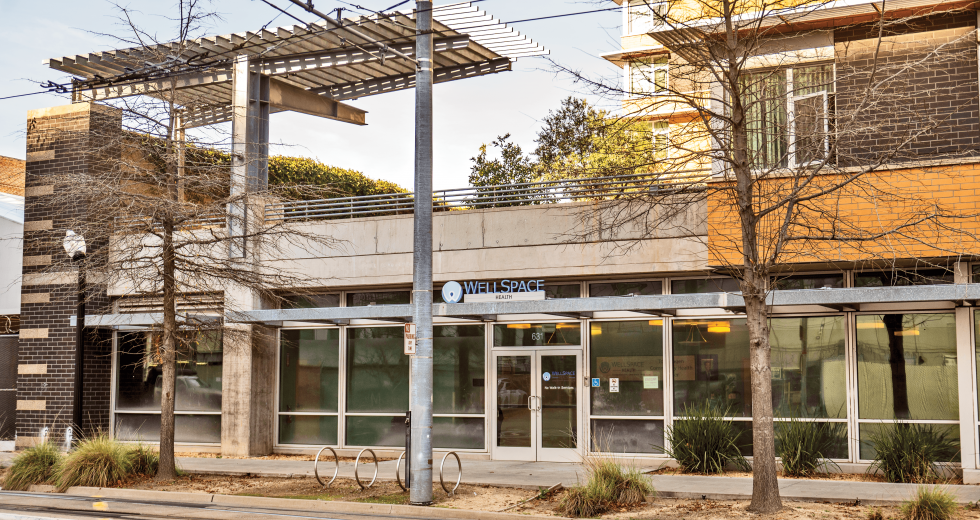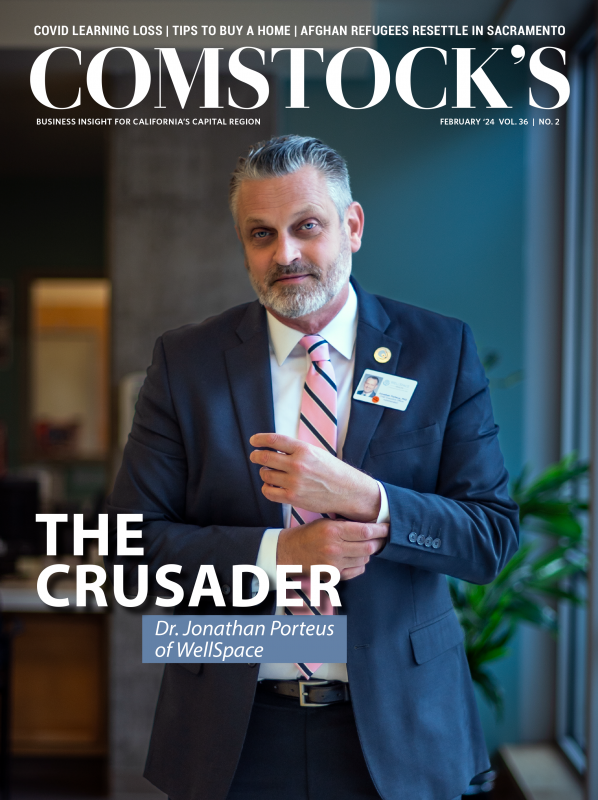Inside an office building in downtown Sacramento, about a half-dozen workers are busy manning a call center, listening and responding 24 hours a day, seven days a week. But it’s not a business operation. These highly trained workers and volunteers are running WellSpace Health’s suicide prevention hotline for a whopping 32 counties in Northern California and doing the life-saving work of calmly talking a person out of despair.
Suicide is an epidemic in America. The Centers for Disease Control released its latest figures in November 2023 that showed the suicide rate is at its highest in 80 years. The CDC reports 49,449 people died of suicide in 2022, the latest year available. More than half of those deaths were by firearms. By stark contrast, FBI figures showed 21,156 homicides in 2022. (The nationwide murder rate fell nearly 13 percent in 2023 to 18,450 murders.) That’s what makes these hotline calls so critical.
“The standard sort of process is that a person calls, and they immediately get the lethality assessment. We need to know how imminent the risk is. And so we do that using a very structured assessment tool,” says Dr. Jonathan Porteus, CEO of WellSpace Health. “If someone is at imminent risk, which is maybe 3 to 5 percent above, we will dispatch a welfare check immediately.”
There are a lot of factors that go into a person contemplating whether to end their life, but the statistics show suicidality has been on a sharp increase since the pandemic forced a lockdown in the country. In 2023, 192 people took their lives in Sacramento County. The same year there were 89 homicides, according to the Sacramento County Department of Health.
WellSpace Health has been running its suicide prevention hotline for 70 years. Started in 1953, the hotline was expanded in July 2022 to include mental health crises as the new national 988 crisis hotline number was implemented. The center, staffed by 66 workers, responds to calls, texts and chats — referred to as crisis sessions — around the clock. In December 2023, WellSpace engaged in 10,460 crisis sessions (7,647 calls and 2,813 text or chat sessions). That is an average of 337 crisis sessions per day, according to spokesman Ben Avey.
“We are now not just suicide prevention but also suicide, mental health crisis, which we’re very honored to do.” Porteus says. “Because basically, despite the dream of having a mental health crisis line for as long as I’ve been a psychologist and many years before that, no one could ever figure it out. And here we were running the national lifeline for suicide prevention very well. It was kind of a band of folks who got together and built one across the country. It became the national lifeline.”
Along with their structured way of assessing a patient, WellSpace also does other innovative approaches to prevention. First, they offer callers resources while they’re still on the line; secondly, if they’ve been hospitalized with a suicide attempt, the person will get a call from WellSpace every day for 30 days; and third, if one of the health care agency’s 140,000 patients says they have suicidal thoughts, they will also receive 30 days of check-in phone calls.
The federal government’s Substance Abuse and Mental Health Services Administration had Columbia University do a study of WellSpace’s followup program and found it to be effective. It is now used as a model for other hotlines across the country, according to Porteus.
“We’re building their capacity to support themselves or, in many cases, building someone’s capacity to feel like they can call back and lean on us. Maybe they go on. It’s less stressful when the crisis is still starting versus when it’s really in full swing. So that’s been very, very effective,” Porteus says.
The call center also takes third-party calls from friends and relatives who are worried their loved one may be thinking of harming or killing themself. A worker will then call the struggling person without revealing who contacted them.
Michael Coleman, a Sacramento writer, recently lost a close friend to suicide over the holidays. He was so shocked he wrote about it for Sac Cultural Hub, hoping to reach others. Not everyone contemplating suicide shows signs. A lot of family members don’t know their loved one is struggling and are rocked when it happens.
“I was really trying to reach the person that might be managing some level of suicidal ideation and just to give a broad picture that those that you leave in the wake of that — it was just devastating,” Coleman told Comstock’s.
The majority of people who kill themselves are white men over 45. (Men are four times more likely to kill themselves than women.) It’s somber to know the CDC starts tracking suicides as young as 10 years old. Josh and Michelle Anderson started JJ’s Hello Foundation in Elk Grove after their 12-year-old son, Joshua “JJ” Anderson, took his life. They now speak to middle and high school students around the Capital Region and also run a support group for family and friends who have lost someone to suicide.
Suicide is the second leading cause of deaths for ages 10-24. Two students in Natomas took their lives on the same day in 2020. UC Davis Health adolescent medicine physician Laura Kester says the challenges that children and teens normally face were amplified by isolation and distancing during the pandemic. (The youth and teen suicide rate spiked during the pandemic but has come down 18 percent for youths 10-14 and 9 percent for 15 to 24 year olds in the latest CDC figures.) Josh Anderson says recent attention to youth mental health is helping.
“Teens tell us that their peers still have a hard time accepting that not being OK is still OK,” Anderson says. “I think because of this, all schools need to focus on youth mental health clubs in school so that more students can feel comfortable talking to each other about how they feel.”
According to the Sacramento County Department of Health, risk factors include previous suicide attempts, history of depression or mental illness, alcohol or drug abuse, physical illness and feelings of isolation.
“We do that lethality assessment. We then keep the person on the line. We resolve about 95 percent of the crisis calls through our hotline,” Porteus says. WellSpace also has a fast response rate of answering calls within two minutes 90 percent of the time.
WellSpace is currently building a new center and trying to reach more people in rural communities. They have sheriffs’ departments trace their calls when someone is despondent to do a welfare check. Porteus would like to offer video calls and virtual meeting rooms as well.
“We have a lot of people who call, and they’re in a cabin under a lot of snow, and they’re not going anyplace, so they’re suicidal. And how do you give them support?” Porteus says.
His dream is to have enough volunteers so they can stay on the phone for hours if needed with a despondent person.
“Even though this is an exceptional suicide prevention and mental health crisis resource,” he says, “I always felt people could do better with more.”
If you or someone you know needs mental health resources and support, please call, text or chat with the 988 Suicide & Crisis Lifeline or visit 988lifeline.org for 24/7 access to free and confidential services.
Judy Farah is the editor of Comstock’s and has previously written about suicide prevention. Two of her neighbors took their lives, and she found out later in life one of her grandmothers killed herself during the Great Depression.
Stay up to date on business in the Capital Region: Subscribe to the Comstock’s newsletter today.
Recommended For You

The Crusading Doctor
Sacramento-based WellSpace Health thrives with a unique approach to homeless and mentally ill patients
The homelessness crisis has seemingly coincided with a lack of sufficient behavioral health resources. Organizations like WellSpace could be well-positioned to take on a growing share of this vital work.

Is the Housing Market Stuck?
High interest rates and low inventory are disrupting the housing market, but there are options for frustrated homebuyers
First-time homebuyers are feeling priced out of the market and fear they may have to rent for the foreseeable future. Homeowners who want to sell are wary of parting with their 3 percent interest rate. As a result, low inventory coupled with high interest rates has made for a very tight housing market.

Photo Essay: Afghans Resettling in Sacramento
The Capital Region is home to more than 10,000 Afghan refugees who fled the Taliban. Comstock’s brings you a few of their stories.

The Evolution of Aesthetics
Women and men have a variety of ways to look their best in the Capital Region
When it comes to “having a little work done,” it’s all about perception. “I was actually one of those people who thought they would never do Botox in their life,” says Shawna Chrisman, nurse practitioner and founder of Destination Aesthetics. “I just wanted to age gracefully.” But a product called Lattise — which she calls her “gateway” — changed her perspective on what that means.

Residential Renaissance
New affordable apartment complexes offer appealing amenities such rooftop terraces, courtyards and shared community spaces
Some of the most exciting architecture being designed and built in the Capital Region today is multifamily residential. Attractive, amenity-rich condominiums, apartments and duplexes are popping up everywhere, proving that single-family luxury homes aren’t the only drool-worthy dwellings on the real estate market.

The Delta in Decline
Wildlife and businesses in the Sacramento-San Joaquin Delta are suffering from lack of fresh water
The life cycle of a salmon, so the story goes, is a heroic journey. The fish emerge from fertilized eggs in a river bed, swim to the ocean where they spend most of their lives and return to give birth in the exact place where they were born.




